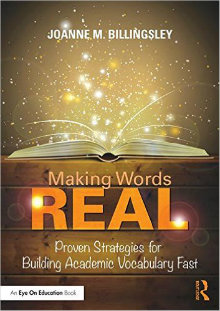Building Vocabulary by Making Words Real
Making Words Real: Proven Strategies for Building Academic Vocabulary Fast
By Joanne M. Billingsley
(Routledge/Eye On Education, 2016 – Learn more)
Reviewed by Anne Anderson
 In the opening pages of Making Words Real: Proven Strategies for Building Academic Vocabulary Fast, readers meet Joanne M. Billingsley and her student Jorge and discover how their desperation led to the development of Vocabulary Magic™.
In the opening pages of Making Words Real: Proven Strategies for Building Academic Vocabulary Fast, readers meet Joanne M. Billingsley and her student Jorge and discover how their desperation led to the development of Vocabulary Magic™.
Thinking back to my own classroom days, when faced with a student who struggled with vocabulary, I grabbed any and every available strategy. Fortunately, for Jorge and for future students, Joanne M. Billingsley tried an idea which lead to the creation of her powerful six-step process that makes words real!
Note: While Card Sort products are available on Billingsley’s website, the book also offers a template (Appendix D) for those teachers who want to make their own cards.
Here’s the Vocabulary Magic Card Sort in Six Steps (see a sample here):
Step 1: Sort It
Step 2: Say It
Step 3: Describe It
Step 4: Read It
Step 5: Check It
Step 6: Expand It

- opportunities to work in and develop small learning communities where students offer and receive support from one another;
- a dramatic increase in student-to-student opportunities for listening, speaking, reading, and writing in small groups;
- the availability of illustrations, teaching diagrams, and concise definitions that support student understanding and retention of new words;
- structured opportunities to relate to new words and to discuss prior knowledge/life experiences within a small group;
- the availability of sentence stems to support speaking and writing in complete sentences;
- encouragement and support in taking academic risks as well as giving and listening to different points of view;
- the availability of immediate feedback followed by an opportunity for self-correction;
- continued opportunities for students to play word games and to use new words in extension activities.
She cautions readers: “Remember, no shortcuts…each step should be followed, or the magic disappears!” (p. 7)
Making Words Real includes specific and detailed instructions for teachers to use when introducing an effective vocabulary strategy. This systematic approach to academic vocabulary instruction includes sample lessons, sentence starters/stems, suggestions for modifying an activity, and follow-up activities. Research that supports the strategy and/or activity is included.
The author provides an abundance of ideas and activities “to dramatically increase student-to-student opportunities for listening, reading, talking, and writing using academic language.” (p. 81) Chapter 6, Read, Talk, Write—Using Academic Vocabulary contains two of my favorite strategies: Sentence Puzzlers and Walk, Talk, Write, and Post.
Sentence Puzzlers (p. 82)
Prior to class, the teacher creates a “puzzle” of a challenging reading passage. It takes a minimum amount of preparation time, and it is not difficult since Billingsley explains each of the 8-steps.
Walk, Talk, Write, and Post (p. 90)
“The process is student-centered, engaging, and it provides meaningful opportunities for students to list, speak, read, and write about content using academic language.” (p. 90) Again, the author has provided a 5-step plan for teachers to implement.
While I was familiar with many of the 21 games and extension activities found in Chapter 7, I did find a new one that could prove to be cognitively challenging. Game #16: Tic-Tac-Toe, Three Words in a Row (p. 116) requires students to write a sentence analyzing relationships between words.
I believe teachers will find Making Words Real: Proven Strategies for Building Academic Vocabulary Fast by Joanne M. Billingsley an extremely valuable resource. The author shares entries from her Teacher Journal, answers Frequently Asked Questions, and includes possible teacher-student and student-to-student dialogues. Teachers who work with English Language Learners will jump for joy at all the tips and ideas she has included.
Anne Anderson is currently an Educational Consultant known for her practical ideas and engaging workshops. Anne’s goal is to help teachers help students. Her positive approach and sense of humor bring encouragement to her audiences. Anne seeks to provide educators with practical solutions to teaching and learning problems. Visit her website www.AnneAndersonEdu.com and subscribe to her bi-monthly newsletter, Spotlight on Success.



































